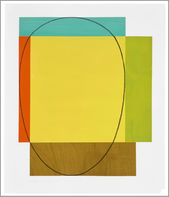
Robert Mangold (born 1937) is a prominent American artist associated with Minimalism and the Color Field movement. Mangold's artistic journey began with studies at the Cleveland Institute of Art and later at Yale University, where he came into contact with influential artists such as Josef Albers. Early in his career, Mangold's work showcased geometric abstraction, and he eventually evolved towards a distinctive form of Minimalism characterized by simple shapes, clean lines, and a sophisticated exploration of color relationships. His minimalist compositions often feature geometric forms like circles and rectangles, showcasing a meticulous precision that reflects both mathematical rigor and a sense of meditative tranquility.
Robert Mangold's work has been featured in major museums and institutions, reflecting his significant impact on the trajectory of contemporary art. The Museum of Modern Art (MoMA) in New York, the Art Institute of Chicago, and the Centre Pompidou in Paris have displayed Mangold's works in solo and group exhibitions. The Dia Art Foundation in Beacon, New York, is home to one of Mangold's monumental installations. Additionally, his pieces are part of the collections at institutions such as the Solomon R. Guggenheim Museum, the Whitney Museum of American Art, and the National Gallery of Art in Washington, D.C. Mangold's unwavering commitment to the exploration of form, color, and space has solidified his position as a key figure in the development of contemporary abstract art.






